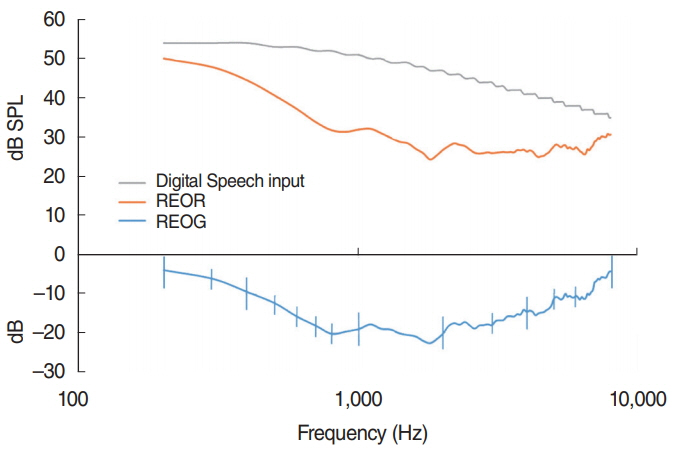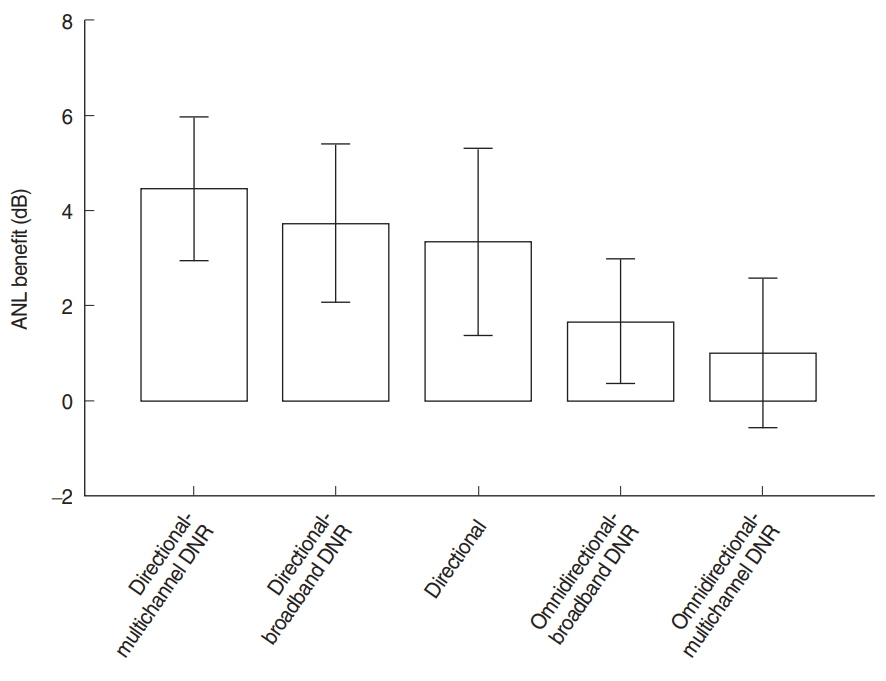Clin Exp Otorhinolaryngol.
2018 Dec;11(4):267-274. 10.21053/ceo.2018.00052.
The Effects of Hearing Aid Digital Noise Reduction and Directionality on Acceptable Noise Level
- Affiliations
-
- 1Department of Audiology, School of Rehabilitation, Shahid Beheshti University of Medical Sciences, Tehran, Iran. hamidjalilvand@sbmu.ac.ir
- 2School of Economic, Allameh Tabataba'i University, Tehran, Iran.
- KMID: 2439853
- DOI: http://doi.org/10.21053/ceo.2018.00052
Abstract
OBJECTIVES
Two main digital signal processing technologies inside the modern hearing aid to provide the best conditions for hearing aid users are directionality (DIR) and digital noise reduction (DNR) algorithms. There are various possible settings for these algorithms. The present study evaluates the effects of various DIR and DNR conditions (both separately and in combination) on listening comfort among hearing aid users.
METHODS
In 18 participants who received hearing aid fitting services from the Rehabilitation School of Shahid Beheshti University of Medical Sciences regularly, we applied acceptable noise level (ANL) as our subjective measure of listening comfort. We evaluated both of these under six different hearing aid conditions: omnidirectional-baseline, omnidirectional-broadband DNR, omnidirectional-multichannel DNR, directional, directional-broadband DNR, and directional-multichannel DNR.
RESULTS
The ANL results ranged from −3 dB to 14 dB in all conditions. The results show, among all conditions, both the omnidirectional-baseline condition and the omnidirectional-broadband DNR condition are the worst conditions for listening in noise. The DIR always reduces the amount of noise that patients received during testing. The DNR algorithm does not improve listening in noise significantly when compared with the DIR algorithms. Although both DNR and DIR algorithms yielded a lower ANL, the DIR algorithm was more effective than the DNR.
CONCLUSION
The DIR and DNR technologies provide listening comfort in the presence of noise. Thus, user benefit depends on how the digital signal processing settings inside the hearing aid are adjusted.
Keyword
MeSH Terms
Figure
Reference
-
1. Kochkin S. MarkeTrak VI: consumers rate improvements sought in hearing instruments. Hear Rev. 2002; Nov. 9(11):18–22.2. McCormack A, Fortnum H. Why do people fitted with hearing aids not wear them? Int J Audiol. 2013; May. 52(5):360–8.
Article3. Ng EH, Rudner M, Lunner T, Pedersen MS, Ronnberg J. Effects of noise and working memory capacity on memory processing of speech for hearing-aid users. Int J Audiol. 2013; Jul. 52(7):433–41.
Article4. Obleser J, Wostmann M, Hellbernd N, Wilsch A, Maess B. Adverse listening conditions and memory load drive a common alpha oscillatory network. J Neurosci. 2012; Sep. 32(36):12376–83.
Article5. Ricketts TA, Hornsby BW. Sound quality measures for speech in noise through a commercial hearing aid implementing digital noise reduction. J Am Acad Audiol. 2005; May. 16(5):270–7.
Article6. Alcantara JL, Moore BC, Kuhnel V, Launer S. Evaluation of the noise reduction system in a commercial digital hearing aid. Int J Audiol. 2003; Jan. 42(1):34–42.7. Boymans M, Dreschler WA. Field trials using a digital hearing aid with active noise reduction and dual-microphone directionality. Audiology. 2000; Sep-Oct. 39(5):260–8.8. Peeters H, Kuk F, Lau CC, Keenan D. Subjective and objective evaluation of noise management algorithms. J Am Acad Audiol. 2009; Feb. 20(2):89–98.
Article9. Dillon H. Hearing aids. 2 ed. Sydney: Boomerang Press;2012.10. Nabelek AK, Tucker FM, Letowski TR. Toleration of background noises: relationship with patterns of hearing aid use by elderly persons. J Speech Hear Res. 1991; Jun. 34(3):679–85.11. Mueller HG, Weber J, Hornsby BW. The effects of digital noise reduction on the acceptance of background noise. Trends Amplif. 2006; Jun. 10(2):83–93.
Article12. Neher T, Grimm G, Hohmann V. Perceptual consequences of different signal changes due to binaural noise reduction: do hearing loss and working memory capacity play a role? Ear Hear. 2014; Sep-Oct. 35(5):e213–27.13. Ansari NN, Naghdi S, Hasson S, Valizadeh L, Jalaie S. Validation of a Mini-Mental State Examination (MMSE) for the Persian population: a pilot study. Appl Neuropsychol. 2010; Jul. 17(3):190–5.
Article14. Kuk F, Keenan D. How do vents affect hearing aid performance? Hear Rev. 2006; Feb. 13(2):34–42.15. Magnusson L, Claesson A, Persson M, Tengstrand T. Speech recognition in noise using bilateral open-fit hearing aids: the limited benefit of directional microphones and noise reduction. Int J Audiol. 2013; Jan. 52(1):29–36.
Article16. Winkler A, Latzel M, Holube I. Open versus closed hearing-aid fittings: a literature review of both fitting approaches. Trends Hear. 2016; Feb. 20:2331216516631741.
Article17. Kuk F, Peeters H, Lau C, Korhonen P. Effect of maximum power output and noise reduction on speech recognition in noise. J Am Acad Audiol. 2011; May. 22(5):265–73.
Article18. Ahmadi A, Fatahi J, Keshani A, Jalilvand H, Modarresi Y, Jalaie S. Developing and evaluating the reliability of acceptable noise level test in Persian language. Sci J Rehabil Med. 2015; 4(2):109–17.19. Lowery KJ, Plyler PN. The effects of noise reduction technologies on the acceptance of background noise. J Am Acad Audiol. 2013; Sep. 24(8):649–59.
Article20. Desjardins JL. The effects of hearing aid directional microphone and noise reduction processing on listening effort in older adults with hearing loss. J Am Acad Audiol. 2016; Jan. 27(1):29–41.
Article21. Nordrum S, Erler S, Garstecki D, Dhar S. Comparison of performance on the hearing in noise test using directional microphones and digital noise reduction algorithms. Am J Audiol. 2006; Jun. 15(1):81–91.
Article22. Brons I, Houben R, Dreschler WA. Acoustical and perceptual comparison of noise reduction and compression in hearing aids. J Speech Lang Hear Res. 2015; Aug. 58(4):1363–76.
Article23. Freyaldenhoven MC, Nabelek AK, Burchfield SB, Thelin JW. Acceptable noise level as a measure of directional hearing aid benefit. J Am Acad Audiol. 2005; Apr. 16(4):228–36.
Article24. Aghsoleimani M, Jalilvand H, Mahdavi ME, Nazeri AR, Kamali M. The acceptable noise level benefit from directionality for listeners with severe hearing loss. Clin Exp Otorhinolaryngol. 2018; Sep. 11(3):166–73.
Article
- Full Text Links
- Actions
-
Cited
- CITED
-
- Close
- Share
- Similar articles
-
- The Acceptable Noise Level Benefit From Directionality for Listeners With Severe Hearing Loss
- Advantages of Binaural Amplification to Acceptable Noise Level of Directional Hearing Aid Users
- Improvement of Speech Intelligibility in Patients with Sensorineural Hearing Loss Using Noise Reduction Algorithms
- Rehabilitation of Sensorineural Hearing Loss: Hearing Aid
- Analysis of Aircraft Noise Area by INM Program around Airport






